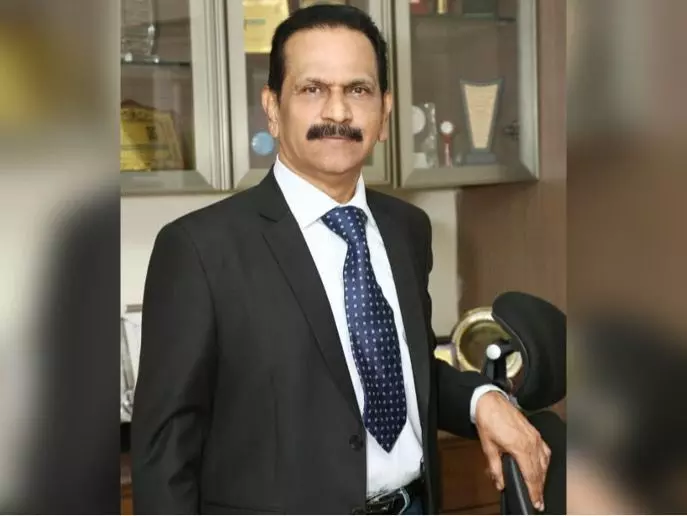Meet Hyderabad's Dr S Vijay Mohan, who was offered ‘visiting professorship’ by US universities
Dr. Vijay Mohan did his MBBS from Osmania Medical College and MD in Internal Medicine from Karnataka University
By Sulogna Mehta
Hyderabad: Top Indian physician earned a rare honor when three US universities offered him a position of ‘visiting professorship’.
The offer was made to Dr. S Vijay Mohan, a senior consultant physician at Care Hospitals, when he delivered guest lectures on tuberculosis at three American University Medical Schools.
A former professor and head of department of Internal Medicine at Deccan College of Medical Sciences, Hyderabad, he has experience of around 23 years in teaching both Indian and foreign students.
Dr. Vijay Mohan did his MBBS from Osmania Medical College and MD in Internal Medicine from Karnataka University.
Passionate about teaching
Apart from organizing and delivering several guest lectures in India and abroad, he has published several articles in state and national medical journals. He also organized Covidcon-2020, the first international online conference on cardiology with 1,500 global doctors, and holds a national record for taking 150 online classes for medical students in 75 days of lockdown. The doctor’s field of interest include teaching clinical medicine, neurocritical care, cardio diabetology, heart failure, metabolic syndrome, and hospital infection control
Speaking to NewsMeter, the doctor elaborates on modern diseases and the plaguing problem of drug resistance, the impact of Covid-19 on the medical profession, healthcare in India now, and the need for a change in the medical education curriculum.
Drug resistance bacteria a serious threat to modern diseases
“Bacteria have an inborn tremendous capacity to develop resistance to antibiotics over some time, particularly, if doctors misuse and overuse them indiscriminately. During monsoon, we face a lot of viral infections for which there is no role for antibiotics. Ironically and unfortunately, the sales of antibiotics go sky-high during these months. This is probably due to lack of awareness among doctors as to when not to use antibiotics,” he says.
He adds that the result of this indiscriminate usage causes bacterial resistance and encourages the growth of Multi-drug Resistant (MDR), Extended Drug Resistant (XDR), and Pan Drug Resistant (PDR) bacteria, posing a severe threat to human lives.
“This is a global burning problem. Today in India we face MDR menace to a tune of 50 to 75 %. Surprisingly the so-called high-end antibiotics also are showing resistance today. We have a strong antibiotic policy and guidelines laid down by the government of India. If all doctors and hospitals follow the ‘antibiotics stewardship program,’ we can reduce the risk of bacterial resistance to significantly low levels,” avers Dr. Vijay Mohan.
COVID-19’s impact on medical profession
Speaking about the pandemic’s impact on treatment, Dr Vijay Mohan says, “COVID-19 has changed the way we learn and practice the unpredictable science of medicine and the practice of ‘Telemedicine’ (Virtual medicine) has gained popularity. With the need for physical distance, during the pandemic, necessitating the switch to virtual consultations, we have had a chance to test the efficacy of impersonal healthcare in a manner that lacks a doctor’s helping human hand touch. This has led to the loss of invaluable physical examinations of patients. Doctors have witnessed a plethora of improvements in the way we diagnose illness but what remained unchanged is the central role that a hands-on physical examination plays in establishing a diagnosis.”
Best diagnosis is a combination of clinical examination and technology
“The modern teachers of medical institutions are focusing less on clinical medicine and today’s students are depending on the investigational tools rather than performing physical examinations on their patients. We also have modern and more sophisticated technology available in the field of diagnostic medicine, which is more objective, more accurate, and more precise than clinical examination alone. So, a combination of clinical examination findings and modern diagnostic test reports is the best way to a diagnostic approach. We must devise a syllabus that places a greater emphasis on hands-on training,” adds Dr Vijay Mohan.
Need for a change in medical education system
“Increasing aging population in India (due to increasing life span) is causing more age-related geriatric diseases like hypertension, diabetes, heart diseases, stroke, lung ailments, and Alzheimer’s disease. The changing and sedentary lifestyle, stress, and faulty food habits are leading to several lifestyle diseases even at younger age. To add to the problem, we have inadequate qualified doctors and nurses. We also often come across several reports of violence against doctors,” says Dr Vijay Mohan.
“Revising the present medical education system seems to be the only solution for the above problems. The National Medical Commission (NMC) is taking steps in this direction. We should also bring out a textbook on the new medical education system and its importance. The government should establish a ‘National Medical Education Standard Board’ or a ‘Medical Teaching Standard Assessment Board.’ They should also establish teachers' training programs in all medical colleges across the country. Such a revised medical education system can improve the healthcare standards,” suggests the doctor.